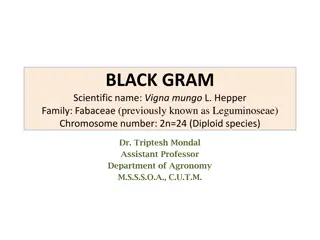Overview of Green Gram (Vigna radiata L.): Economic Importance, Origin, and Classification
Green gram, scientifically known as Vigna radiata L., is a highly digestible pulse crop with various uses such as consumption as whole grains or dal, making flour for cakes, and as fodder for cattle. It is grown widely in Southern Asia and other countries, with India being a significant producer. Green gram is also valued for its role as a green manure crop, improving soil health and fertility through nitrogen fixation. Its origin is traced back to India and Central Asia. The crop exhibits characteristic variations in seed color, flower color, and pod color, contributing to its classification.
Download Presentation

Please find below an Image/Link to download the presentation.
The content on the website is provided AS IS for your information and personal use only. It may not be sold, licensed, or shared on other websites without obtaining consent from the author. Download presentation by click this link. If you encounter any issues during the download, it is possible that the publisher has removed the file from their server.
E N D
Presentation Transcript
GREEN GRAM Scientific name: Vigna radiata L. Wilczek Family: Fabaceae (previously known as Leguminoseae) Chromosome number: 2n=24 (Diploid species) Dr. Triptesh Mondal Assistant Professor Department of Agronomy M.S.S.S.O.A., C.U.T.M.
Economic importance and uses: Green gram pods are used as vegetables. Green gram is highly digestible pulse crop than any other pulse crop. Moong is consumed as whole grains as well as dal in a variety of ways in homes. Moong halwa is said to be very nutritious. Sprouted whole moong is used in south India for preparing curry or a savoury dish. It is used mostly as dal/porridge in north India. When moong beans are allowed to sprout, ascorbic acid (vitamin C) is synthesized. The amount of riboflavin (B ), niacin (B ) and thiamine (B ) are also increased. Green gram flour is used in cakes. Starch is used in making noodles. The husk and haulms are used as good fodder for cattle. The husks of seeds is soaked in water 1st, then used as cattle feed whereas haulms are chopped into small pieces and fed to the cattle. Due to shorter duration, green gram can be fitted well in several multiple cropping systems
Green gram is also grown as a green manure crop. Inclusion of green gram in cropping systems improves soil health and fertility. Being a close growing crop, it helps in reducing soil erosion and also checks weed growth. Being a leguminous crop, it fixes atmospheric nitrogen to the soil i.e., biological N fixation. Green gram/moong/mung bean/golden bean/yellow bean is excellent source of high quality protein. On an average, it contains about 24-25% protein, 63% carbohydrate, 1.15% fat along with good amount of minerals like Ca, Fe & K.
Origin and distribution: According to N.I. Vavilov (1926), the origin of green gram is India and central Asia. Greengram is widely cultivated throughout Southern Asia. Myanmar, Pakistan, Thailand, Srilanka, Indonesia, China and Africa are the principal countries of green gram cultivation. Area, Production and Productivity: In world, moong is grown in about 5 mha with the total production of about 2.5 million tonnes of seeds or grains and a productivity of 500 kg/ha. It is the 3rd most important pulse crop of India after chickpea (1st) and field pea (2nd). In India, moong is grown in almost all states. It is grown in about 3.8 mha with the total production of about 1.56 million tonnes of seeds or grains and a productivity of 413 kg/ha. The important mung bean growing states are Andhra Pradesh, Odisha, Maharashtra, Madhya Pradesh, Tamil Nadu, Rajasthan and Bihar. Rajasthan has the highest acreage (0.37 mha) and production of green gram (1.56 mt) in India. Maximum productivity of green gram is found in Punjab followed by Jharkhand.
Classification A classification of mung bean in India was made by Bose in 1932, who grouped them into 40 different types mainly on the basis of leaf size, flower colour, pod colour and seed colour. Green gram has the following characteristic variations: 1. Seed colour Seeds are either green, black, brown or yellow 2. Seed surface Either dull or shiny 3. Flower colour Either light yellowish olive or olive yellow 4. Pod colour Ripe pods are either iron grey or olive grey or snuff brown
Botanical description It is a small herbaceous, annual plant growing to a height of 30-100 cm with a slight tendency of twining the upper branches. The central stems are more or less erect while the side branches are semi erect. The leaves are trifoliate with long petioles. The leaflets are being large, ovate and entire. Both the stems and leaves are covered with short hairs generally shorter than those in black gram. The flowers are of various shades of yellow colour and are produced in a cluster of 10-20 in axillary racemes on long pedicels. The pods are 6-10 cm long, round slender with short pubescence. The seeds are small and nearly globular. The colour of seeds is usually green but yellow brown or purple brown seeds also occur. The hilum is white, more or less flat. The colour of cotyledons is yellow. Germination of seed is epigeal type. Green gram is fully self pollinated and self fertile crop.
Climatic condition Green gram is a tropical pulse crop largely grown under semi arid and subtropical environment. It is well suited for all rainfed areas having annual rainfall of 600-1000 mm. It requires hot climate and can tolerate high temperatures upto 40 C. Moong is considered to be the hardiest among all the pulses. It can be grown from mean sea level (MSL) to an elevation of 2000 m. It is grown in kharif and pre-kharif seasons in north India but in the south and south west India, it is grown in all the 3 seasons (i.e., kharif, pre-kharif and rabi). Soil condition Green gramis cultivated on a wide range of soils from sandy loams to black cotton soils. In north India, the crop is cultivated on well drained loamy soils or sandy loam soils where as in south India, it is cultivated on red-lateritic soils. This crop does not withstand waterlogging. Optimum soil pH: 6.5-7.5. Saline and alkaline soils are not suitable for moong cultivation.
Cropping systems Moong is grown with pigeon pea / sorghum / pearl millet / maize / cotton in mixed cropping during kharif season. Intercropping of moong can be done with spring planted sugarcane. Some important cropping systems with moong bean in north India are as given below: Maize-Wheat-Green gram (in pre-kharif) Maize-Toria-Green gram (in pre-kharif) Potato-Wheat-Green gram (in pre-kharif) Green gram (in kharif)-Wheat Green gram (in kharif)-Potato One important cropping systems with moong bean in south India is as given below: Rice-Green gram (in rabi) Rice-Rice-Green gram (in rabi) Greengram-Maghi Jowar Practiced in Khammam Greengram-Tobacco followed in black cotton soils
Land preparation There is no need for a fine seed bed preparation. One or two ploughings followed by two or three cross harrowings and each harrowing should be followed by planking is adequate for a kharif and pre- kharif crop to make the field levelled and to minimise the loss of moisture by evaporation from the soil surface. The field should be well levelled and free from weeds. Greengram is cultivated on deep soils during rabi on rice fallow soils. There is no tillage for rice fallow (in case of relay cropping) as the green gram seeds are broadcasted in standing crop of rice about a week before the harvest of rice. Seed and Sowing Time of sowing: Kharif: Sowing is done with the onset of monsoon in the 2nd fortnight of June to 1st fortnight of July Rabi: In central and south India (Madhya Pradesh, Andhra Pradesh, Tamil Nadu and Odisha), moong is sown in rabi season too. It should be sown in October-November. Pre-kharif: In Uttar Pradesh, Punjab, Haryana, Delhi, Bihar and West Bengal, moong is grown in pre-kharif or summer season under irrigated condition along with kharif cultivation. Pre-kharif sowing is done in mid march to mid april. a) b) c)
Seed rate and spacing: For sole cropping in kharif season: 12-15 kg/ha For green manure crop: 25-30 kg/ha For pre-kharif crop: 25-30 kg/ha For rabi crop: 25 kg/ha For rice fallow as relay crop: 30-35 kg/ha (broadcasting of seeds) Spacing: In kharif: 45 cm 10 cm In rabi: 30 cm 10 cm In pre-kharif: 30 cm 10 cm Depth of sowing: 5-7 cm under rainfed condition and 3-5 cm under irrigated condition Method of sowing: Seeds are sown behind the plough (kera and pora method) and seed drilling Plant population: 33 plants/m or 3.33 lakhs/ha is the optimum plant population of green gram
Varieties Kharif- LGG 450, LGG 407, LGG 460, WGG 37, MGG 295, M2 267, Pusa 105, MGG 347, MGG 348, PDM 54. Rabi - Lam M2, LGG 460, LGG 410, Pusa 105, LGG 407, MGG 295, WGG 37, TM96-2 Summer & Spring Season - Pusa Baisakhi and Co 4 Rice fallows - LGG 410 Tolerant to high temperature - Padma, Sunaina & Co 4 Early maturing (60-65 day) - Pusa Baisakhi, K851,PS16, Padma, Sunaina, Co 4 and Pusa Bold (Vishal) In kharif, rabi and pre-kharif (early duration varieties show less incidence of pest and diseases. First mung bean variety released in Odisha during 1980: Dhuli First mung bean variety released in India during 1948: T1 Resistant varieties: YMV resistant- LGG 407, LGG 460, WGG 2, WGG 37, PDM 54, ML 267 Leaf Curl resistant- LGG 460, MGG 295 Angular Black Leaf Spot resistant- LGG 407, WGG 2 Powdery Mildew resistant- TM 96-2, TARM 18
Some popular green gram varieties recommended for different states of India: 1. Pusa Baisakhi Andhra Pradesh, Telangana, Delhi, Assam, Bihar, Himachal Pradesh, Haryana, Jammu and Kashmir, Kerala and Karnataka, Maharashtra, Odisha, Tamil Nadu, Rajasthan, Uttar Pradesh and North Eastern Hill Region T 44 - Andhra Pradesh, Telangana, Haryana, Jammu and Kashmir and Rajasthan Co 4 Kerala and Tamil Nadu Pant Moong 1 Punjab, Haryana, Uttar Pradesh, Rajasthan, Madhya Pradesh Mohini (S 8) Delhi, Kerala and Tamil Nadu PDM 54 West Bengal, North Eastern States, Uttar Pradesh, Bihar, Assam, Jammu and Kashmir and Andhra Pradesh 2. 3. 4. 5. 6.
Some important green gram varieties with the characteristics 1. Pusa Baisakhi It is a selection from Type 44. Plants are semi erect and seeds are greenish, medium bold. Avg. test weight is 35-40 g. 2. Sabarmati It is a cross of PLM 1066 Pusa Baisakhi. It is an early maturing variety. 3. Type 44 It was developed in 1962 by a cross between Type 1 Type 49. in Uttar Pradesh. Plants are semi spreading, medium in height, pods containing 11-14 seeds. Seeds are dull green, medium in size with a test weight of 36 g. 4. Type 1 This variety was developed in Uttar Pradesh during 1948 by selection from local material of Mazaffarpur in Bihar. It matures in 60-65 days, semi spreading type, pods are blackish brown at maturity. Seeds are dull green, medium in size with a test weight of 30 g. 5. Pant Moong 1 It was developed by cross between LM 294-1 Type 44 and identified in 1983 for north plains west zone. It matures in 65-70 days in spring and summer and 75-80 days in kharif. Plants are tall with dark green foliage. Seeds are green with the avg. test weight of 30 g. 6. Mohini (S 8) It was developed from the cross between BR 2 Type 2. It matures in 70-75 days. Plants are erect. Pods are medium, long and containing 10-12 seeds. Seeds are shiny, greenish, medium bold with the average test weight of 40-45 g.
Fertilizer application Rhizobium inoculations considerably minimize the need for nitrogenous fertilizer application. In rainfed crop: 10 kg N/ha (Starter dose (or) booster dose) & 30 kg/ha P O as basal In irrigated crop: 20 N kg/ha (Starter dose) & 40 to 50 Kg/ha P O as basal Nearly 40 kg/ha N, 10 kg/ha P O & 15 kg/ha K 0 is removed by 1 tonne of green gram seeds. Biofertilizers: For Mung bean, 500 g of rhizobium culture is sufficient for the seeds required to be sown in 1 ha i.e., 2.5 packets/ha (Since, 1 packet = 200 g). Green gram fixes 20 Kg N/ha/year. Green gram associated with VAM (Vesicular Arbuscular Mycorrhizal) Which is a PO absorber. So, it absorbs greater amounts of phosphorous. The fertilizer should be applied either at the time of sowing or just before sowing (i.e., 24 hours before sowing) in such a way that fertilizers are placed about 5-7 cm below the seed.
Water management: For Kharif crop, irrigation is not required but adequate drainage is required in the field because this crop is sensitive to waterlogging condition. Waterlogging at flowering & pod filling reduce the yield upto 75% and more. Winter & summer crop require 2-3 irrigations. But 5-6 irrigations can be given based on soil moisture status. Rice fallow greengram crop is not irrigated. The 1st irrigation should be given about 20-25 DAS. The subsequent irrigations should be given at an interval of 12-15 days. No irrigation should be given when the crop is in full bloom stage. Critical stages are flower initiation (at 35 DAS) and pod filling (at 55 DAS) Total water requirement for green gram cultivation: 300 400 mm
Weed Management: Critical period for weed competition is upto 35 DAS. Two weedings are enough to keep the crop free from weeds. 1st weeding should be done at 20-25 DAS and 2nd weeding is done at 45 DAS. Recommended herbicide in kharif crop is Fluchloralin (Basalin) @ 1.5 Kg a.i/ha in 800-1000 litres of water as pre-plant incorporation (PPI). Weeds do not pose a serious problem in pre-kharif crop. However, one weeding should be done after 1st irrigation. Production constraints of Green gram: 1. Moisture stress:Generally, kharif sown crop suffers from moisture stress due to intermittent dry spells during the growth phase. Hence, drought tolerant varieties may be recommended like PDM-54, MH 309, K-851 etc. 2. Pre harvest sprouting: Kharif sown crop matures in August or September, usually the crop is caught in rains at the time of harvest. Hence, there is a sprouting of seeds in the pods causing heavy losses both in terms of yield and quality. A variety resistant to pre harvest sprouting is LGG-450. 3. Non synchronous in maturity: It is usually harvested by pickings. Most of the varieties are non-synchronous in maturity. Hence, harvesting is done in 2-3 pickings. Varieties tolerant to non-synchronous maturity such as PDM 54, MH 309 and Pusa 105 are more susceptible to diseases.
Harvesting: For kharif crop, the harvesting is done by picking the pods. Shattering of pods is a great problem with pulse. Therefore picking should be done as soon as the pods mature. Harvesting should be completed in two to three pickings. The varieties which are quite synchronous in maturity, require only two pickings. For rabi & summer crops, harvesting is done by cutting the whole plant with sickle from the base when the plants show about 90% maturity. Threshing: The produce is cleaned and sun dried to about 12 percent moisture content. Then threshing is done manually. After that seeds are stored. Yield and yield components: Major yield components are number of plants per unit area, number of pods per plant, number of seeds per pod and test weight. A well managed crop may produce 1.2 to 1.5 t/ha of green gram seeds.
Difference between green gram and black gram Green gram or moong Black gram or urd 1. Plants are tall and less spreading type 1. Plants are shorter than moong plants and usually more spreading type 2. Pods are erect, slender and large 2. Pods are sub erect, short and stout 3. Pods have short and spare hairs 3. Pods have long and dense hair 4. Seeds are globular in shape and smaller than urd seeds 4. Seeds are oblong in shape and larger than moong seeds. 5. Hilum is flat 5. Hilum is concave 6. Seed colour is golden/yellow/brown/green 6. Seed colour is olive black

















































